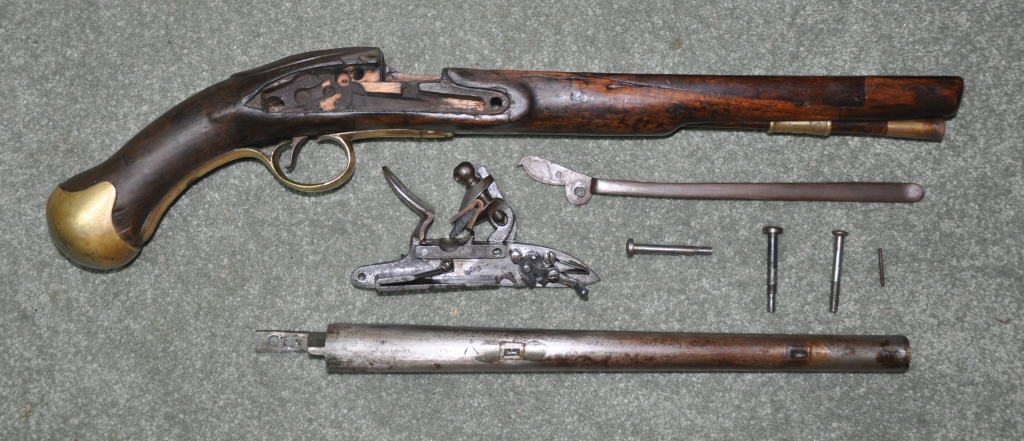The instant that sparks from the flint ignite the priming powder in the pan. Click to enlarge (photo: Alan Gibbins).
My blog about the author Patrick O’Brian includes a picture of me holding an early 19th century flintlock Sea Service pistol that I acquired in Canada, the same type that you can see Russell Crowe wielding as Captain Jack Aubrey in the 2003 film Master and Commander. In the film the enemy ship is French, the Acheron, whereas in the novel it’s American, one of the superb new frigates that confronted the Royal Navy during the War of 1812. Since its bicentenary that war has received long-overdue attention in Canada, with focus on the achievements of British forces and the local militia – many of them from loyalist families who had moved north from the former American colonies – in resisting American incursions into Upper Canada, and in taking the fight as far south as Washington DC. I’ve always been fascinated by the naval aspects of that war, so being able to shoot a weapon that may have remained in Canada since that time has special interest for me.
If you click on the video at the bottom of this posting you can see me loading and shooting the pistol, taken with a GoPro camera mounted on my head to give a shooter’s eye perspective. Sea Service pistols of this pattern were manufactured between 1801 and 1812, by which time some 27,800 pairs had been produced. Alongside India Pattern ‘Brown Bess’ muskets - such as the one here - they’re probably the most common surviving British small arm from the Napoleonic Wars period. Handling this pistol, weighing a hefty three pounds, with its foot-long barrel and massive brass-capped butt, brings home the ferocity of the hand-to-hand shipboard fighting portrayed so vividly in Master and Commander; once the pistol had been fired it could be reversed and used as a club, to devastating effect. If you look closely at the forestock of my pistol you can see a split, expertly repaired at the time, that may have been damage caused by that type of close-quarters action.
The barrel is stamped beneath the breech with the name GILL, one of a family of sword cutlers and gunmakers based in Birmingham from the 1790s who supplied the Board of Ordnance as well as the East India Company. The trade card above dates from 1806, the year after the Battle of Trafalgar. In the pictures below (click to enlarge) you can see the naval belt-hook among the disassembled parts as well as the stamped number 59 in the trigger guard, probably the rack number of a shipboard store or naval shore establishment. The detailed history of this pistol can never be known, but the strong likelihood that it saw naval use during the period of the Napoleonic Wars - possibly in the War of 1812, on the Great Lakes or at sea - gives added poignancy to handling and firing it today.
VIDEO: click on the image below to see me loading and shooting this pistol:
References
Bailey, De Witt, 2009, Small Arms of the British Forces in America 1664-1815. Woonsocket, Mowbray Publishers (Sea Service pistols, p. 192-5).
Bailey, De Witt, and Nie, D.A., 1978, English Gunmakers. Arms and Armour Press (on the Gill family, p, 37).






